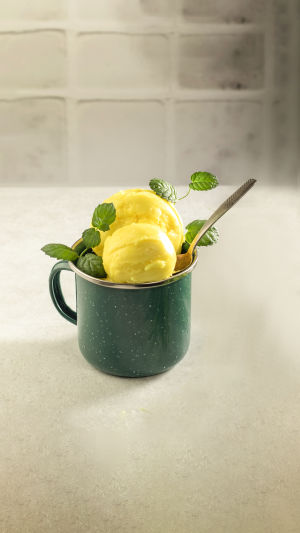Summer has arrived once again, with the scorching sun beating down and the pavement radiating heat, making it uncomfortable to walk.
During this time, the desire for ice cream and cold drinks becomes irresistible. Children, in particular, are drawn to these treats and their resistance is often low.
Different families have varying attitudes toward allowing their children to indulge in ice cream. Some families believe that there's nothing wrong with their children eating ice cream, especially in hot weather. On the other hand, some families strictly restrict their children from consuming ice cream and may not even keep it in the freezer to discourage its consumption.
So, can children enjoy ice cream during the summer, and at what age can they start? Furthermore, are there any precautions to be aware of?
Ice cream is a frozen dessert made primarily from drinking water, cow's milk, milk powder, cream (or vegetable fat), and table sugar. It also contains various food additives. The main ingredient, as mentioned before, is table sugar. But what exactly is table sugar?
Table sugar is a type of sugar consumed in food. During the food production process, it mainly refers to free sugars such as white sugar, fructose, glucose, and lactose.
Why should babies avoid consuming sugar until the age of 3?
There are several dangers associated with babies consuming sugar before the age of 3. It can lead to issues such as obesity, and tooth decay, and even have long-term health effects, including an increased risk of high blood pressure and diabetes in adulthood.
Therefore, it is advisable for babies under 3 years old to avoid consuming ice cream during the summer. However, for babies over 3 years old, can they enjoy ice cream? Are there any precautions to keep in mind?
Babies should not consume excessive amounts of ice cream in one sitting, as it can cause abdominal pain, gastroenteritis, and even laryngospasm. Overindulgence may also lead to nutritional deficiencies.
In the summer, babies need to consume ice cream slowly to avoid stimulating visceral vasoconstriction, which can weaken the digestive function of the gastrointestinal tract and its ability to fight off infections. This can potentially lead to gastroenteritis, cholecystitis, and even hepatitis.
Additionally, some children may experience headaches due to the cold temperature of the ice cream and the adverse stimulation of the trigeminal nerve.
When it comes to ice cream production and storage, there is a risk of contamination with pathogenic bacteria such as salmonella and listeria. Therefore, it is crucial to choose a reputable brand when selecting ice cream for your baby.
If the ice cream has thawed and appears soft or wilted, indicating it has been repeatedly thawed, it should not be given to the child.
The main difference between ice cream and ice cream lies in their fat content, with ice cream typically having a lower fat content.
Regardless of whether it is ice cream or ice cream, most of these treats are high in fat and sugar to achieve a silky and sweet taste. While it's okay to allow your child to indulge occasionally to satisfy their curiosity and cravings, moderation is key.
In fact, whether it's ice cream or other snacks, children who have been allowed to enjoy them since childhood often develop better self-control. On the other hand, children who were restricted from consuming ice cream during their early years might develop a strong desire for it as they grow older, potentially leading to excessive consumption.
When it comes to children and ice cream consumption, it's important to consider their age, consume it in moderation, and be mindful of any potential health risks. By striking a balance and making informed choices, children can enjoy their ice cream treats while maintaining a healthy lifestyle.





